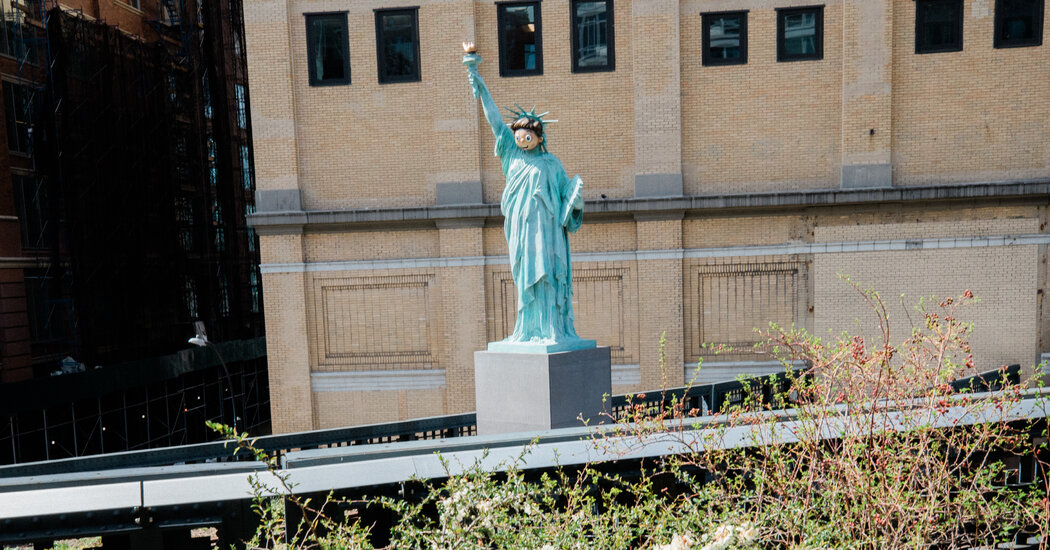
Folks out for a stroll on the High Line this week are pulling out their iPhones to photograph a quizzical new sculpture, “You know who I am,” at the end of a rail spur in a valley of buildings at West 16th Street. Measured to the torch, the 16-foot-tall bronze copy of the Statue of Liberty — her classical face and straight Greek nose fitted with an emoji-like mask of an Asian boy — stands like a question mark asking visitors to connect two incongruous dots: the draped, classical figure that everyone knows, and a cartoon face with a button nose and startled eyes.
The Italian-born artist Paola Pivi took one of America’s most familiar symbols and made it new and strange. First she meticulously copied the figure down to her fingernails from a plaster cast taken from an original bronze by the French sculptor Frédéric- Auguste Bartholdi. With the mask, she gave the statue — commissioned by the High Line — a different age, race and gender, at the same time coupling her bronze figure to a harrowing story originating in India. Instead of a generalized tale of tired and poor “huddled masses,” the mask tells the story of a single, vulnerable orphan.
Pivi, 51, specializes in producing artworks that are basically question marks in physical form. Figuring it out is on you. The rare Italian artist who picked up a book about Dada before a book on the Renaissance, she has dropped puzzles in public spaces around the world. Bypassing Italy’s long tradition of pictorial realism, she had nothing to unlearn but everything to invent. Her birth as a conceptual artist was immaculate.
“Marcel Duchamp led me to discover art without form — the experience is not in front of your eyes, but inside the brain, cerebral not retinal,” she said last week in her East Village gallery, Perrotin, which will exhibit a site-specific installation in late June.
Fresh off a plane from Anchorage, Alaska, where she now lives, Pivi was discussing her work, career, and Dada. In an optically complex, visually self-contradictory dress with a two-tone, long-sleeve blouse atop a pleated silk skirt, she wears Dada on her sleeve.
“Dada was exciting, and liberating,” she says. “Dada taught me that art communicates, like books. As an artist, you have to go into a deeper state of consciousness and being, where you’re not in complete, conscious control.”
Her first exhibited sculpture was a showstopping 18-wheel truck inexplicably flipped on its side at a prestigious international show in Pescara in 1997. For verisimilitude, she basted its underside in grease. “How I Roll” (2012), was a twin-engine Piper Seneca rotating horizontally on its wing as though performing aerial acrobatics in New York’s Central Park under the haughty gaze of the nearby Plaza Hotel.
Dada taught Pivi, who had studied chemical nuclear engineering in college, to embrace irrationality. In a show that opens on April 22 at the Andy Warhol Museum in Pittsburgh, “Paola Pivi: I Want it All,” she sculpts in feathers. Gamboling in its clinical white galleries, life-size polar bears, smothered in Day-Glo plumage, play tag, dance, hang on trapezes, scratch itches, and generally introduce raucous joy to the hushed precinct. Perhaps Pivi is drawing attention to the humanity of polar bears as they face environmental extinction?
Polar bears live, she says, “on her doorstep” in Alaska, to which she was introduced when she witnessed, from a Piper Cub, the Iditarod, Alaska’s famous 1000-mile dog sled race. “I went to see the finish line at Nome and fell in love with Alaska,” she said. “Nature there is mind blowing, and the Indigenous cultures of Alaska are extraordinary.” She shares her admiration for Alaska with her husband, a Tibetan composer, poet, songwriter, documentarian and freedom activist whose stage name is Karma Culture Brothers. She met him there in 2006. He titles all her pieces.
The lazy interpretation of “You know who I am” might be that Pivi was displacing a familiar object to an unfamiliar context, as Duchamp did when he “found” his urinal, “Fountain,” by signing the ready-made and submitting it for exhibition. Pivi “found” the Statue of Liberty by transposing her objet trouvé from New York Harbor to the High Line (itself a found object), effectively signing it with the mask. The cartoonish face on a classicized statue jump-starts the statue with an incongruity that magnetizes passers-by. Pivi is decontextualizing and re-sculpting a symbol rather than a rote object.
“Immigration is a topic that touches many lives, and ‘You know who I am’ addresses that experience in an accessible and even playful way,” said Cecilia Alemani, director and chief curator of High Line Art. Pointing out that the Statue of Liberty is visible in the distance from the park, she calls Pivi’s work “an invitation to think about the individual people whose collective experiences — both hopeful and challenging — make up the reality of immigration in the United States.”
Contrary to the Sphinx-like character of Pivi’s other work, “You know who I am” has a back story, accessible on the spot via the cellphone.
We learn that the mask, full of innocence and boyish charm, is an abstraction of the face of her son, Norbu. Pivi and her husband met and adopted him in 2012 when the 5-year-old was living in the Tibetan Children’s Village in Dharamshala, the headquarters of the large Tibetan community in exile in India. Pivi likes to say that their son adopted them when, in an instant of spontaneous recognition, he hurtled across a room toward them with a smile in full throttle: “He jumped into my arms,” she said. “I started crying.” Karma photographed the event.
The emotional bond was immediate and easy. The adoption, not so much.
The president of the Tibetan Children’s Village had initiated and approved the adoption, and Norbu moved in with the couple, then staying in India. But after five months, the Village reclaimed the boy to send him to France in another arrangement.
In 135 hearings that lasted all the way up to India’s Supreme Court and the High Court of New Delhi, the couple made their case about the legitimacy of the adoption against the word of prominent Tibetan figures. Despite what she called their “reputation for being the most compassionate people in the world — holy, spiritual, pure — they lied brutally, ruthlessly, saying in court that we wanted to traffic the child, that we were Chinese spies, that we had kidnapped him.”
Pivi paid for all the court and lawyer’s fees from earnings from her art, which she continued to produce while using India as her home base. Karma’s photographs and iPhone recordings added documentary evidence to signed papers. (They have just published a book, “Circle,” telling the saga in print, with an accompanying CD.)
The family’s ordeal also informed “Lies,” a 2018 installation first shown at the Bass Museum in Miami Beach in which she mounted 92 small TV screens in information grids displaying changing images. The filmed facts — birds flying, a man smoking a long cigar — were visual truths, while audio clips of the lies from today’s post-truth reality of misinformation and disinformation played as a sound track.
“During the years of the hearings and after, I had come to understand, despite my shock, that lies had become ubiquitous,” she says. “Before it had been shameful to lie, but then it became accepted.”
During the hearings, Norbu had become deeply interested in the Statue of Liberty as a symbol of human rights and freedom — and his own. “He was fascinated by the statue and wanted to see it,” she said. “His fixation inspired the artwork.”
Finally, after four years of hearings, the adoption was legitimized by Indian courts. “Petition is without any merit. Dismissed,” read the 2016 judgment. The couple won the right to leave India with Norbu. The United States had an official document that allowed Norbu, now legally adopted but otherwise stateless, and therefore paperless, to enter the country and achieve citizenship on entry. “American law had a mechanism that was a medium of freedom that, in our case, sustained the Statue of Liberty’s promise,” Pivi said.
“‘You know who I am’ was a milestone that opened my work,” she continues. “The Statue of Liberty was born political. It represents the relationship between people and the status of freedom they get — or not — from society.” Her bronze, she added, “speaks to me of something intimate about the identity of one person — in our case, Norbu — and his relationship to the society.”
If Lady Liberty is now Norbu, she will become five other people during the coming year, when Pivi places personalized emoji-style masks on the statue at two-month intervals. Pivi is translating an ideal into real people, and each mask represents a case study in an individual’s biography of freedom. The next will be that of Marco Saavedra, a restaurateur in the Bronx who was brought to the United States from Mexico as a child, without papers. A “dreamer,” he very recently won asylum.
“Some stories will be happy, and some not,” Pivi concludes. “Freedom is controlled by others.”




